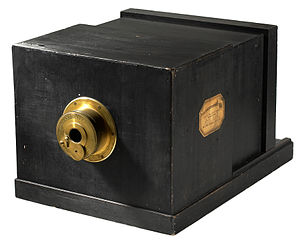From Daguerreotype to gelatin silver: A 30-minute crash course in the history of photographic film processes
posted Friday, May 17, 2013 at 5:13 PM EDT

In six short, excellent videos from the George Eastman House -- each about three to six minutes long -- the history of film photography is told in terms of the processes behind it, from the Daguerreotype to gelatin silver prints. The Eastman House staff, led by Alison Nordstrom, senior curator of photographs, takes us through the history of each process. They describe each process, its impact on photography and how it changed the broader society. Nordstrom, for instance, reminds us that because of photography, for the first time millions of people could see the faces of family members who had died long before they were born.
This "See: Untold Stories" series is a wonderful evocation of photography from the 19th and early 20th centuries. Presented in an easy, conversational manner, dry technical information is often bracketed by bits of humor. For example, did you know that the most popular photographic process of the late 19th century was the albumen print and that it was actually made from egg whites? It was so popular that the demand for fresh eggs went through the roof and many large photographic studios resorted to maintaining chicken coops in the back of their shop to keep up with their needs.
Although the series starts, naturally enough, with the Daguerreotype process, it does give a tip of the hat to the French inventor, Joseph Nicéphore Niépce who, in the early 1820s made the very first fixed photographic images. He made them by coating a piece of porcelain with asphalt (!) and processing it in turpentine (!). Daguerre became Niépce's partner and, after Niépce's death, went on to perfect the process of fixing images that bears his name, although this time the images were made on coated and polished silver coated plates.
Even by today's standards the Daguerreotype is remarkable, and as noted in the video, these photographs are so sharp that with high-powered microscopes it is possible to see details in the image that are invisible to the naked eye.
The Daguerreotype video is followed by five others: the Wet Plate Collodion process, the Albumen process, the Woodburytype process, the Platinum process and the Gelatin Silver process. You can watch them all here.
As a photographer, it is fascinating to actually see these processes in action as demonstrated by Mark Osterman, Eastman House Process Historian. He walks us through each process, and we watch as a piece of glass or metal is prepared with an emulsion, then exposed and processed. The videos show how each process produces a different kind of image, each with its own special qualities that affected the way they were used. It is also refreshing to see that although sometimes these early processes were a bit complicated, they are eminently doable today.
The Eastman House does a great job, too, of drawing upon their own huge collections of photographs and cameras, to make the stories come to life. Where else could you see a working Woodburytype press or an original 1888 "Kodak" camera -- the sixth one ever to be made -- that's still operational?
The "See: Untold Stories" is a great set of videos that is a must-see for photographers. Even though we now live in an almost completely digital age, these processes are our photographic heritage.